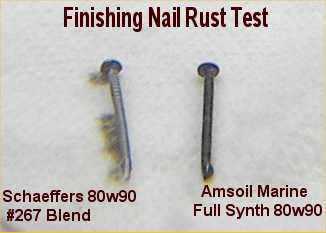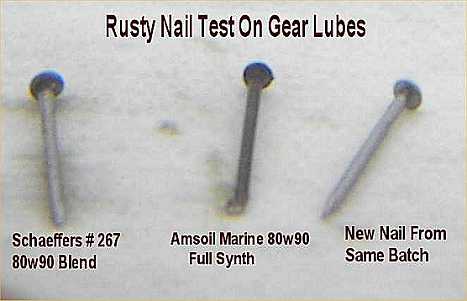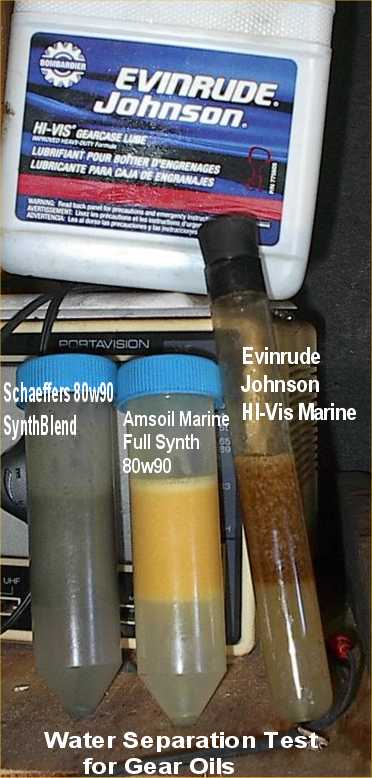quote:
Originally posted by Andy H:
Bob,
The primary point of the comment is that the 'shake the oil and water test' is only going to be a realistic lower unit environment if you've got a leaky gear box. Yes, that is exactly correct.
We drain the gear lube after a full summer of running so the engine is stored for the winter with fresh lube.That's good, so if I understand this, then a good maintenance practice is changing the oil after a full summer of running. In a lower unit with good seals, you might have some milky-looking lube from the slight amount of moisture that seeped in over 6 months of use and stayed emulsified in the gear lube. Ok, so now it's alright to have milky gear oil which indicates water in the oil In a well-maintained lower unit, you're not going to be running that much water, and it's not going to settle out.So, since the water doesn't settle out, then it wont produce any damage? Hmmm, did you ever think about how much heat water can induce into this unit due to the amount of oxidation levels that has incurred on this gear oil? If you have a leak and take on more water than normal, there's enough room under the gear set at the bottom of the lower unit for a bit of water to settle out and be free of the gears and prop shaft, so you're not going to have the steel gears and other parts sitting in water the way your nail was. Well, instead of taking the time to check the height of the gear oil in the unit, why not just pull the drain and drain off the water, then closing off this unit and top off?
A properly designed lube SHOULD take a long time for the water to settle out for just the reason your nail demonstrates. If a gear oil has turned milky it is now a bad lubricant and has now oxidized to a point it cannot fight off the chemical reaction of water in the lubricant. This is one indicator of a weaken oil.. Two, when water is in the oil, heat now will rise in the operation of this unit. Water, when agitated, will produce more bubbles, which if you agitate then will create more heat. This will put more heat stress on the oil, put more heat stress on the gears and bearing, oxidize the bearing, causing it to pit and acid build up, also puts more heat to the seals thus drying out the plyablity of the seal and causing heat stress to such a point it can allow more water to enter in.
To say that an equal amount of water and oil in a tube is a representative lower unit environment is misleading at best. Actually, it demonstrates exactly what will happen if you leave a gear oil in a lower unit with water milked up in it. Let me help explain even better... Water and oil don't mix correct?, since this is the case, water can attach to metal surfaces and cause rust and pitting of the metal surfaces. Even if oil is around, water is still present. The interesting thing about this demonstration is this, EVEN though both nails were submerged into water, BOTH were in LIKE conditions and BOTH reacted DIFFERENTLY. One no damage at all while the other completely rusted.
Take a wheel bearing on a boat trailer... it too is enclosed with grease, but yet, bearings go out constantly, why? because of water intrusion. When water is present, it breaks down the oil/grease, creating more heat, also creating rust spots and pitting of the race and bearings. Is this what you'd call ideal? Of course not, and to think fooling yourself that water mixed with oil is ok, that's ok with me, but please think about what you're saying as there is no difference between a gear oil and a marine oil and since you did not answer my questions above I can only figure you didn't realize this.
Like many things, marketing plays a role in product design and many do is provide the same product just with a different label. It's for people that feel it has to have marine on it.
Just like grease, most marine greases have a lithium complex but when water is mixed which happens everytime a hot bearing rolls into a cold water which sucks in the water from the heat cooling down, it cannot keep from mixing and milking up and loses it ability to maintain proper lubrication(just like your gear oil) thus wheels seem to be missing on many boat trailers on the side of the road. Yet, like you say, right lubricant for the right job.
It's a great site and there's lots of great info here. But there are folks that don't know when something is 'tongue-in-cheek' and might decide that the test is good and use the improper product in expensive equipment. Don't we both know it! And hopefully you'll start to see just how you are missing the boat(no pun intended) on this issue with this test
Andy




